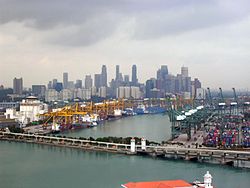Economy
Asia has the second largest nominal GDP of all continents, after Europe, but the largest when measured in purchasing power parity. As of 2011, the largest economies in Asia are China, Japan, India, South Korea and Indonesia. Based on Global Office Locations 2011, Asia dominated the office locations with 4 of top 5 were in Asia, Hong Kong, Singapore, Tokyo, London and Shanghai. Around 68 percent of international firms have office in Hong Kong.[26]
In the late 1990s and early 2000s, the economies of the PRC[27] and India have been growing rapidly, both with an average annual growth rate of more than 8%. Other recent very high growth nations in Asia include Israel, Malaysia, Indonesia, Pakistan, Thailand,Vietnam, Mongolia, Uzbekistan, Cyprus and the Philippines, and mineral-rich nations such as Kazakhstan, Turkmenistan, Iran,Brunei, United Arab Emirates, Qatar, Kuwait, Saudi Arabia, Bahrain and Oman.
According to economic historian Angus Maddison in his book The World Economy: A Millennial Perspective, India had the world's largest economy during 0 BCE and 1000 BCE.[28][29] China was the largest and most advanced economy on earth for much of recorded history,[30][31][32][33] until the British Empire (excluding India) overtook it in the mid-19th century. For several decades in the late twentieth century Japan was the largest economy in Asia and second-largest of any single nation in the world, after surpassing the Soviet Union (measured in net material product) in 1986 and Germany in 1968. (NB: A number of supernational economies are larger, such as the European Union (EU), the North American Free Trade Agreement (NAFTA) or APEC). This ended in 2010 when China overtook Japan to become the world's second largest economy.
In the late 1980s and early 1990s, Japan's GDP was almost as large (current exchange rate method) as that of the rest of Asia combined.[citation needed] In 1995, Japan's economy nearly equaled that of the USA as the largest economy in the world for a day, after the Japanese currency reached a record high of 79 yen/US$. Economic growth in Asia since World War II to the 1990s had been concentrated in Japan as well as the four regions of South Korea, Taiwan, Hong Kong and Singapore located in the Pacific Rim, known as theAsian tigers, which have now all received developed country status, having the highest GDP per capita in Asia.[34]
It is forecasted that India will overtake Japan in terms of nominal GDP by 2020.[35] By 2027, according to Goldman Sachs, China will have the largest economy in the world. Several trade blocs exist, with the most developed being the Association of Southeast Asian Nations.
Asia is the largest continent in the world by a considerable margin, and it is rich in natural resources, such as petroleum, forests, fish, water, rice, copper and silver. Manufacturing in Asia has traditionally been strongest in East and Southeast Asia, particularly in the China, Taiwan, South Korea, Japan, India, the Philippines, and Singapore. Japan and South Korea continue to dominate in the area of multinational corporations, but increasingly the PRC and India are making significant inroads. Many companies from Europe, North America, South Korea and Japan have operations in Asia's developing countries to take advantage of its abundant supply of cheap labour and relatively developed infrastructure.
According to Citigroup 9 of 11 Global Growth Generators countries came from Asia driven by population and income growth. They are Bangladesh, China, India, Indonesia, Iraq, Mongolia, Philippines, Sri Lanka and Vietnam.[36] Asia has four main financial centres: Tokyo, Hong Kong, Singapore and Shanghai. Call centres and business process outsourcing (BPOs) are becoming major employers in India and the Philippines due to the availability of a large pool of highly skilled, English-speaking workers. The increased use of outsourcing has assisted the rise of India and the China as financial centres. Due to its large and extremely competitive information technology industry, India has become a major hub for outsourcing.
In 2010, Asia had 3.3 million millionaires (people with net worth over US$1 million excluding their homes), slightly below North America with 3.4 million millionaires. Last year Asia had toppled Europe.[37] Citigroup in The Wealth Report 2012 stated that Asian centa-millionaire overtook North America's wealth for the first time as the world's "economic center of gravity" continued moving east. At the end of 2011, there were 18,000 Asian people mainly in Southeast Asia, China and Japan who have at least $100 million in disposable assets, while North America with 17,000 people and Western Europe with 14,000 people.[38]
*Darrell E.F
Twitter/Instagram : @damnrell



No comments:
Post a Comment